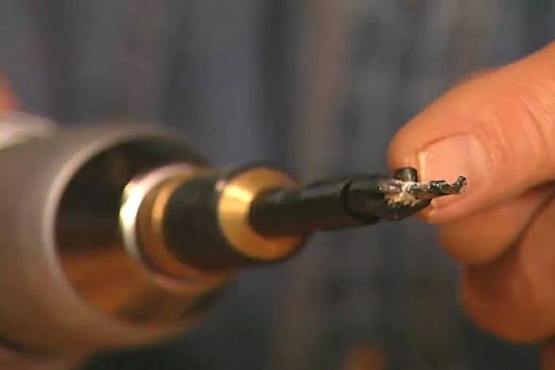RON – VO
TODAY’S HOUSE CALL TAKES ME TO THE FAMOUS FRENCH QUARTER OF NEW ORLEANS.
THIS BASTION OF FOOD, MUSIC AND FUN IS SUCH A FAVORITE GETAWAY FOR NEW JERSEY RESIDENTS, ERIC SHNEPF AND PATRICE PELLECHIA, THE COUPLE RECENTLY PURCHASED A VACATION CONDOMINIUM IN THIS 1830’S BUILDING, LOCATED JUST TWO BLOCKS FROM BOURBON STREET.
NOW, ERIC AND PATRICE CONTACTED ME ABOUT INSTALLING STORM SHUTTERS FOR THEIR WINDOWS. BUT FRENCH QUARTER ORDINANCES REQUIRE THAT ANY EXTERIOR ADDITIONS BE HISTORICALLY ACCURATE.
SO TODAY, I’M HELPING ERIC AND PATRICE BUILD A SET OF EARLY 19TH CENTURY SHUTTERS.
Ron:
Well, I’m going to set up some tools down here in the courtyard. I think that’s going to be a good place for us to work. So if you guys are ready…
Eric Schnepf:
Yes sir.
Ron:
Shall we start?
Patrice Pellechia:
Sure.
Ron:
OK.
NEW –VO:
OUR SHUTTERS WILL BE MADE FROM PLANKS OF WOOD –FIR IN THIS CASE. THE PLANKS WILL BE JOINED TOGETHER BY CUTTING TONGUE AND GROOVE JOINTS ALONG EACH EDGE.
ERIC:
Is that for strength or is that just a, a construction technique or?
RON:
Well both actually. Uh back in the days before plywood the only way you could really make up a large panel of wood was to take narrower strips like this and connect them together. So this is a very efficient way of doing that.
RON-VO:
NOW WHILE FRENCH QUARTER CRAFTSMEN IN THE 1830’S WOULD HAVE USED A HAND PLANE TO CREATE THE TONGUES AND GROOVES, WE’LL ACHIEVE THE SAME RESULTS, MUCH MORE RAPIDLY, WITH A ROUTER.
Ron:
What I’ve done is taken a router, very similar to this one and I’ve mounted it up underneath this router table right here. You can see the cutter sticking up from the bottom. Now the cutter is going to spin.
And while it’s spinning we’re going to pass this board over it and it’s going to cut a groove right down the side here. Okay? So we’re set to go. Who wants to go first?
ERIC:
Patrice.
PATRICE:
Okay. Great.
RON:
Patrice? Okay. Come around here. Got your safety glasses on. That’s good. Make sure that okay, this is flat.
RON-VO:
PATRICE GUIDES THE FIRST BOARD THROUGH THE ROUTER USING RUBBER- FACED SAFETY GRIPS. USING THESE SHE CAN PRESS THE BOARD FIRMLY AGAINST THE TABLETOP FOR A CONSISTENT CUT.
RON:
All right. And there’s your first groove. And I’d say a perfect groove it is.
PATRICE:
Why thank you.
RON – VO:
ONCE WE’VE COMPLETED ALL OUR GROOVES, WE’LL CUT TONGUES ON THE OPPOSITE SIDE OF EACH BOARD.
FOR THIS, WE INSTALL A STRAGHT CUT BIT ON THE ROUTER. YOU’LL NOTICE AS ERIC PASSES THE BOARD THROUGH THE ROUTER, HE’S NOT ACTUALLY FORMING A TONGUE…IT’S MORE LIKE…HALF A TONGUE.
AFTER THIS FIRST PASS, WE TURN THE BOARD OVER AND RUN IT THROUGH THE ROUTER AGAIN… THIS TIME, CREATING THE FULL TONGUE.
RON:
And there you go. One tongue.
RON-VO:
NOW WITH TONGUES AND GROOVES CUT FOR EACH SHUTTER, WE’RE GOING TO ADD A DECORATIVE FEATURE THAT’S AS GOOD AN IDEA TODAY AS IT WAS IN 1830.
USING A THIRD ROUTER BIT, WE’RE GOING TO CUT WHAT’S KNOWN AS A “BEAD” ALONG THE TONGUE SIDE OF EACH BOARD. THE BEAD HELPS DISGUISE THE JOINT BETWEEN THE BOARDS MAKING EACH SHUTTER MORE LOOK LIKE A SINGLE WIDE PANEL.
Ron:
Instead of laying the wood flat, this time we’re gonna turn it up like this. Okay, so whereas before it was important to press down on the bed to keep it flat, now it’s important to press into the fence right here, and keep this right through like this. Eric, why don’t you come around and take the first one. Okay, are you ready?
ERIC:
Yes sir.
Ron – VO:
OUR NEXT STEP IS TO CREATE RABBET JOINTS ALONG THE INTERIOR EDGES OF EACH SHUTTER. THESE JOINTS WILL OVERLAP WHEN THE SHUTTERS ARE CLOSED AND PREVENT LIGHT, WIND AND WATER FROM GETTING THROUGH.
THE ROUTER IS SET UP JUST AS IT WAS FOR OUR TONGUES, BUT THIS TIME, INSTEAD OF MAKING TWO PASSES WE’LL MAKE ONLY ONE.
WITH ALL OUR MACHINING COMPLETE, WE’RE READY TO MOVE ON TO ASSEMBLY.
Ron:
Uh, guys, we’re going to lay these out now. What we’re going to do here…these are actually the inside edges of the shutters. Here’s that rabbet that we cut on there. It’s going to overlap, just like that.
RON-VO:
WE BEGIN ASSEMBLING THE SHUTTERS FROM THE CENTER OUTWARD TO THE EDGES, SLIDING EACH TONGUE INTO THE CORRESPONDING GROOVE. I FIND IT EASIER TO ASSEMBLE THE SHUTTERS FIRST AND TRIM THEM TO SIZE AFTERWARDS.
RON:
Don’t you love that feeling when they slide together like that?
PATRICE:
Like a puzzle, but not.
RON:
Nothing like a good fitting wooden joint.
ERIC:
What’s next?
RON – VO:
WE’RE GOING TO HOLD THE BOARDS TOGETHER BY ATTACHING STRIPS OF ONE BY FOUR LUMBER ACROSS THE BACKS.
WE CUT THREE BOARDS CALLED BATTENS TO LENGTH FOR EACH SHUTTER AND ATTACH THEM WITH SCREWS COUNTERSUNK SO THAT THE HEADS ARE BELOW THE SURFACE.
RON:
All righty. Now one thing I hate in a restoration project like this is to see Phillips head screws. Because if you see that, you know, new, right?
ERIC:
Uh huh.
RON:
But I like them because they’re rust resistant, they’re gonna hold real well. So I’d like to cover these up. We did counter sink the holes. Like I always say, putty is your friend.
RON –VO:
WE’VE CONCEALED THE SCREW HEADS, TURNED THE SHUTTERS OVER AND TRANSFERED THE WINDOW MEASUREMENTS TO THEM. USING A CIRCULAR SAW, ERIC CUTS EACH SHUTTER TO LENGTH, THEN PATRICE GETS READY TO CUT THEM TO WIDTH.
RON:
You’ve been waiting all day for this, haven’t you?
PATRICE:
Baited breath.
RON:
I know you’re a little nervous about using this saw.
PATRICE:
Mm-hmm.
RON:
But it’s gonna be just as easy as all the other tools.
RON:
Ok now, let’s see what you did.
PATRICE:
Dusty.
RON:
Look at that.
PATRICE:
Well.
RON:
What a beautiful cut, huh?
PATRICE:
Tell ya, I think I have a second career coming.
RON:
I think you do!
RON – VO:
WELL OUR SHUTTERS ARE ASSEMBLED, BUT THEY STILL NEED HINGES. USING A HAMMER AND CHISEL ERIC CUTS MORTISES OR RECTANGULAR RECESSES ON THE OUTSIDE EDGES.
RON:
Like Gepetto’s shop here. Tap tap tap tap.
RON-VO:
THE MORTISES WILL ALLOW THE HINGES TO BE INSTALLED FLUSH WITH THE SURFACE. THESE HINGES WERE PURCHASED AT A FRENCH QUARTER STORE THAT CARRIES PRE-CIVIL WAR ERA REPRODUCTION HARDWARE FOR RESTORATION PROJECTS JUST LIKE THIS ONE.
FINALLY, WE’RE READY TO HANG THE SHUTTERS.
RON:
OK. Shutter number one, coming in. We’re approaching the moment of truth.
PATRICE:
That’s right.
RON:
When we see if the shutter and the window are gonna become good friends.
All right, Eric. Why don’t you grab the shutter, there…Let’s see if we can get a fit out of this. Just set it right on the shims there. That’s just to give us some clearance underneath so that it won’t drag on the sill.
RON – VO:
WITH THE SHUTTERS RESTING ON SHIMS, PATRICE TRANSFERS THE HINGE LOCATION ON THE SHUTTERTO THE WINDOW FRAME. THEN ERIC CHISELS OUT TWO MORTISES ON THE INSIDE OF THE WINDOW FRAME SO WE CAN ATTACH THE MATCHING HINGE LEAF.
FINALLY, WE HANG OUR VINTAGE 1830 SHUTTERS.
RON:
Ah, now let’s see if we got a fit.
PATRICE:
Like a glove.
ERIC:
They’re wonderful Ron.
RON:
Very nice. Very nice.
ERIC:
They’re wonderful. They match the front of the building perfectly.
RON:
And you know if you get a coat of paint on those, they’ll look like they’ve been there for a hundred years.
RON – VO:
WELL THIS HOUSECALL MAKES ME APPRECIATE WHAT A NATIONAL TREASURE THE FRENCH QUARTER TRULY IS. AND FOR ME, HELPING RESTORE A SMALL BIT OF HISTORY HERE – EVEN IN THE FORM OF A PAIR OF SHUTTERS -- IS A REAL PRIVILEGE.








